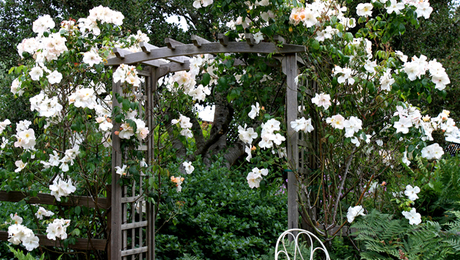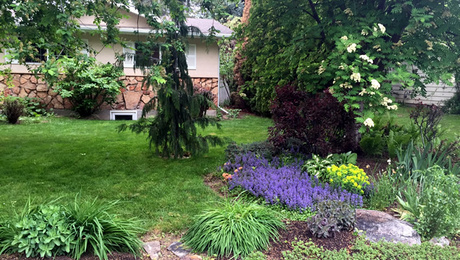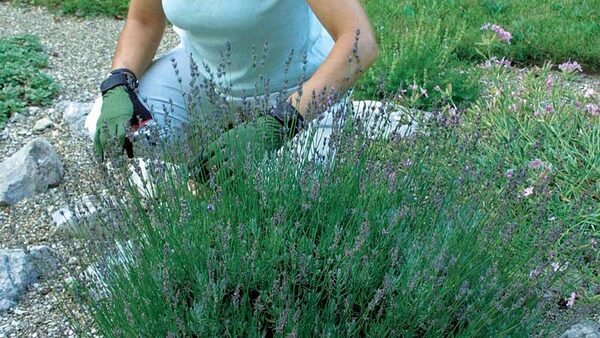
A few years ago, having arrived at the startling age of 70, I realized that it might be a good idea to start replacing some of the perennials in the garden with less-demanding shrubs. At a leisurely pace and with the help of Brid Craddock, a talented gardener and designer who comes for half a day a week, I began making minor changes. Then, in the spring of 2005, a drastic and heartbreaking change was thrust upon me: My husband, Martin, died.
Although he was never a gardener, we had functioned as a team for 45 years. Martin mowed the lawn in the summer, vacuumed up the leaves in the fall, and made the power equipment purr with goodwill. After retiring, he took on the grocery shopping, errands, and a dozen other household tasks so that I could spend more time gardening and writing. In his absence, everything has suffered.
But to allow the garden—the living, ever-changing story of our lives—to go to wrack and ruin would have been unthinkable. So I have spent the past year trying to figure out what I can do to streamline operations and how to get help doing the things that are beyond me. So far, I am holding my own. Here are the simple but significant adaptations I’ve made to my gardening habits.
Cover your beds with mulch

My garden is large—perhaps an acre and a half—but simple, as befits a former cow pasture. A 100-foot-long perennial border follows the contours of the east-facing hillside. Behind it, paths run athwart the slope in the shade of overhanging maples and among deciduous shrubs underplanted with ferns and hostas.
The lawn stretches north between the long border and a huge, old juniper hedge. The so-called “new borders,” dug in 1990, partially enclose this panel of lawn. Beyond these beds lie shade plantings and the woodland garden. A crescent bed planted chiefly with daylilies is the most recent addition.
It has always been a trick, keeping up such a large place. But settling for tough, ordinary perennials—like daylilies (Hemerocallis cvs., USDA Hardiness Zones 3–10), rudbeckias (Rudbeckia spp. and cvs., Zones 3–11), sedums (Sedum spp. and cvs., Zones 3–9), and catmints (Nepeta spp. and cvs., Zones 3–8)—worked well enough. And mulch solved what otherwise might have been a real maintenance problem.
Introduced to the benefits of organic mulch 25 years ago, I’ve been covering the perennial beds with year-old leaves ever since. This management technique has allowed me to garden, almost singlehandedly, for a great many years. I gather leaves into an expansive pile in the fall. In spring, I mulch every square inch of soil between the perennials with 3 inches of these hoarded leaves. This layer of leaves shades out weed seedlings, conserves moisture, and breaks down during the season, providing organic plant food.
Shredded wood-chip mulch, purchased in bulk, is the next best thing. Brid and I have been using it in the wilder parts of the garden: along the paths, on the shrub plantings, under a pair of old apple trees, and on the crescent bed. It doesn’t break down as quickly and is heavier than the leaf mulch. It also lasts longer and has proved the solution to managing these large, rough areas. These efforts should be all that is necessary for the season, except for occasional weed pulling. It has been a struggle, however, to complete the job before summer arrives, and as we are both busier than before, we now need help in the form of some professionals.
Replace perennials with shrubs and trees

In the perennial beds, I have accelerated the replacement of perennials, which I began in 2000. Daylilies and false sunflowers (Heliopsis helianthoides, Zones 4–9) found new homes with friends and neighbors. In their place, I planted a dwarf Alberta spruce ( Picea glauca var. albertiana ‘Conica’, Zones 2–6) and a narrow, compact arborvitae (Thuja cv., Zones 2–9). Happily, the evergreens have proved a great addition with their year-round color and solid, conical forms. In another area, a mass of asters has given way to the vase shape and bronze foliage of an eastern ninebark (Physocarpus opulifolius ‘Diabolo’ , Zones 3–7).
Last fall, Brid and I embarked on an ambitious overhaul. Many daylilies were sacrificed to make way for a linden viburnum (Viburnum dilatatum* ‘Asian Beauty’, Zones 5–8), a weigela (Weigela florida ‘Variegata Nana’, Zones 5–8), two compact oakleaf hydrangeas (Hydrangea quercifolia ‘Sike’s Dwarf’, Zones 5–9), a golden spirea (Spiraea japonica* ‘Goldmound’, Zones 4–9), and a small but ravishing variegated Korean dogwood (Cornus kousa ‘Gold Star’, Zones 5–8). Most of these shrubs need pruning only once a year, instead of the regular deadheading, staking, and frequent division that many perennials require.
Perhaps the quickest route to lower maintenance in a flower bed is the elimination of plants that require even a little too much care. Gone from my garden are the balloon flowers and Russian sage; both have lax stems that invariably flop over. While I miss them, the beds are less trouble and look better. In the long run, a beautiful border is a manageable one. Fewer kinds of perennials, each with their own individual demands, make for ease of management.
Simplify your approach to edges
Harder than giving up a bit of variety within the beds is letting go of their once immaculately cut edges. Edging every bed once or twice a season is just too time-consuming now. But I have learned to live with a reasonably tidy edge maintained using a string trimmer. The trick is to leave a space between the edge and the plants, to keep that space weeded, and to trim carefully and uniformly.
Another strategy that helps maintain the lines of the beds is to choose foreground plants that remain neat and attractive all season. In the sun, I favor low-growing grasses and naturally compact, orderly perennials that have good-looking foliage and either bloom for a long time or recover quickly from shearing.
Two strategies for tidy edges



1. Maintain crisp edges with plants that keep their compact forms throughout the growing season. Here are a few examples.
Plants for sunny spots
Blue oat grass Helictotrichon sempervirens (Z 4–9)
‘Blue Wonder’ catmint Nepeta racemosa ‘Blue Wonder’ (Z 4–8)
‘Hameln’ fountain grass Pennisetum alopecuroides ‘Hameln’ (Z 6–9)
Lesser catmint Calamintha nepeta (Z 5–9)
Sedums Sedum spp. and cvs. (Z 3–9)
Variegated liriope Liriope muscari ‘Variegata’ (Z 6–10)
Plants for shaded areas
Barrenworts Epimedium spp. and cvs. (Z 5–9)
Bigroot geranium Geranium macrorrhizum (Z 4–8)
Gingers Asarum spp. and cvs. (Z 2–9)
Hellebores Helleborus spp. and cvs. (Z 4–9)
Hostas Hosta spp. and cvs. (Z 3–9)
Vancouveria Vancouveria hexandra (Z 5–8)

2. Instead of digging in new border lines, use a string trimmer to keep the grass low and the edges manicured.
Don’t rush to fill spaces


For the disciplined gardener, an easy way to reduce maintenance is to resist filling every gap that appears in the landscape. I am not a disciplined gardener, but adopting a wait-and-see attitude toward empty spaces has paid dividends. For 15 years, a lovely flowering cherry (Prunus ‘Hally Jolivette’, Zones 6–8) flourished among the dwarf conifers in my island bed. Then, quite suddenly, it died.
With uncharacteristic restraint, I did not replace the tree, and I was glad because the conifers rejoiced to find themselves in full sun once again. The ‘Blue Star’ juniper (Juniperus squamata ‘Blue Star’, Zones 4–9) became bluer, and the golden false cypress (Chamaecyparis pisifera ‘Filifera Aurea Nana’, Zones 4–8), which had remained green in the shade of the cherry, was restored to its former bright self. Then, during the winter of 2004, voles set upon the juniper, leaving only the Alberta spruce and the false cypress. In terms of design and balance, that was all right, too; the remaining shrubs needed the extra room. The garden changes, and the plants adapt. The gardener must do the same.
Gardening is all about change, about hanging on and letting go. At a certain stage, the gardener must look at every plant and ask hard questions: “Have I the time and energy to give this plant what it needs? And if not, do I love it enough to give it what it needs anyway?” Often, alas, the answer may be “No.” But then there are the exceptions, like a blue-and-white-striped balloon flower. It was given to me by a perfect stranger. He found it as a seedling in his aunt’s garden and named it ‘Louise’ in her honor. I could never willingly part with ‘Louise’. In some ways, I just can’t let go.

















Comments
I so admire your spirit and open-mind. Thank you for a lovely article.
I'm so sorry to hear that your husband passed away, but I'm delighted to read that you are continuing to garden, to find new ways of dealing with garden maintenance issues. You are truly inspiring. I wish you much joy.
Condolences, but the tips for us aging Boomers are right on the mark. We can't stop gardening, but, perhaps, we must make adjustments and get some help. . .
I'm in a similar transition because my own health is declining. What you said is true of aging as well as gardening, and it helped me accept that I have to let go of some of the colorful, vibrant plants I've loved and replace them with ornamental shrubs -- plus scale the whole thing back where I can:
"The garden changes, and the plants adapt. The gardener must do the same. Gardening is all about change, about hanging on and letting go."
Thank you so much for this article. This is something that I really needed to realize and apply in my life. I am getting older :-) and it is getting harder for me to keep up with maintaining this addiction that I have. Not only am I addicted but because I believed that every spot should be filled, it consumed all of my time & money. It's time that I adapt to my age & abilities and make some changes. I need to down-size... make my gardening easier....and to free up time to enjoy some of the other Blessings life have to offer. Thank you. :-)
Log in or create an account to post a comment.
Sign up Log in